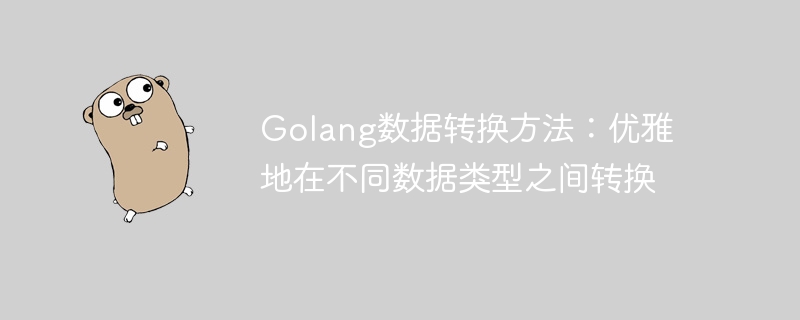Home >Backend Development >Golang >Golang data conversion method: convert between different data types elegantly
Golang data conversion method: convert between different data types elegantly
- WBOYWBOYWBOYWBOYWBOYWBOYWBOYWBOYWBOYWBOYWBOYWBOYWBOriginal
- 2024-02-19 08:00:08735browse

Golang is a powerful programming language. Its simplicity and efficiency make it one of the preferred languages for many developers. In actual development, we often encounter conversion problems between different data types, and how to perform data conversion gracefully has become an important skill. This article will discuss how to elegantly convert between different data types in Golang through specific code examples.
1. Convert string to integer
In Golang, converting string to integer is a common operation. This functionality can be achieved using the built-in strconv package. The following is a sample code:
package main
import (
"fmt"
"strconv"
)
func main() {
str := "123"
num, err := strconv.Atoi(str)
if err != nil {
fmt.Println("转换失败:", err)
return
}
fmt.Println("转换后的整数:", num)
}2. Convert integer to string
As opposed to converting string to integer, converting integer to string is also a common task. You can use the Itoa function in the strconv package to implement the function of converting integers to strings. The following is a sample code:
package main
import (
"fmt"
"strconv"
)
func main() {
num := 123
str := strconv.Itoa(num)
fmt.Println("转换后的字符串:", str)
}3. Conversion between arrays and slices
In Golang, arrays and slices are two commonly used data structures. Sometimes we need to convert an array to a slice or a slice to an array. The following is a sample code:
package main
import "fmt"
func main() {
arr := [3]int{1, 2, 3}
slice := arr[:]
fmt.Println("数组转切片:", slice)
slice2 := []int{4, 5, 6}
arr2 := [3]int{}
copy(arr2[:], slice2)
fmt.Println("切片转数组:", arr2)
}4. Conversion between structure and JSON
In actual development, conversion between structure and JSON is a very common operation. Golang provides the encoding/json package to convert structures and JSON data. The following is a sample code:
package main
import (
"encoding/json"
"fmt"
)
type Person struct {
Name string `json:"name"`
Age int `json:"age"`
}
func main() {
p := Person{Name: "Alice", Age: 30}
jsonData, err := json.Marshal(p)
if err != nil {
fmt.Println("转换失败:", err)
return
}
fmt.Println("结构体转JSON:", string(jsonData))
var p2 Person
err = json.Unmarshal(jsonData, &p2)
if err != nil {
fmt.Println("转换失败:", err)
return
}
fmt.Println("JSON转结构体:", p2)
}Conclusion
Through the above code example, we understand how to elegantly convert between different data types in Golang. These conversion operations are often used in actual development. Mastering these techniques can allow us to deal with data conversion issues more efficiently. I hope this article can be helpful to you, and you are welcome to share more tips and experiences in Golang data conversion.
The above is the detailed content of Golang data conversion method: convert between different data types elegantly. For more information, please follow other related articles on the PHP Chinese website!
Related articles
See more- Detailed explanation of examples of converting database data into JSON format
- SQL Server 2008 Enhancements to Handling Implicit Data Type Conversions in Execution Plans
- mysql converts large amounts of data into arrays
- Detailed explanation of commonly used data conversion and usage in CGO projects
- How to use CONVERT function in MySQL for data type conversion

